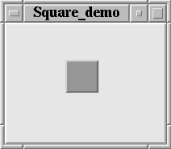The Tk::Square Widget
The Tcl/Tk distribution contains a Square widget that demonstrates the basic structure of a C widget. It’s a simple square of variable size and color that can be moved around a window by dragging it with a mouse. It has a keyboard binding to an “a” that starts and stops an animation that varies the widget’s size over time, so that it appears to throb.
Tcl/Tk Example
Although Perl/Tk code produced Figure 21-1, this
Tcl/Tk example creates an identical window. The square widget,
.s, is packed, assigned three bindings, and given
the keyboard focus. The mouse button bindings move the square to the
cursor’s current position, and the “a” binding
toggles the animation’s state. In the Perl/Tk version,
we’ll see how to move the bindings into the Tk::Square class
proper (seems reasonable, since it’s unclear exactly what a
square widget should do anyway).
square .s
pack .s -expand yes -fill both
bind .s <1> {move %x %y}
bind .s <B1-Motion> {move %x %y}
bind .s a animate
focus .s
Figure 21-1. A Tk::Square with a raised relief
This procedure moves the square to a given position. The (x, y)
coordinate comes from the %x and
%y binding codes, analogous to the
$Tk::event->x and
$Tk::event->y calls. The
size method returns the pixel length of the
square’s side, and the position method
actually repositions the square.
proc move {x y} { set a [.s size] .s position [expr $x-($a/2)] ...Get Mastering Perl/Tk now with the O’Reilly learning platform.
O’Reilly members experience books, live events, courses curated by job role, and more from O’Reilly and nearly 200 top publishers.

